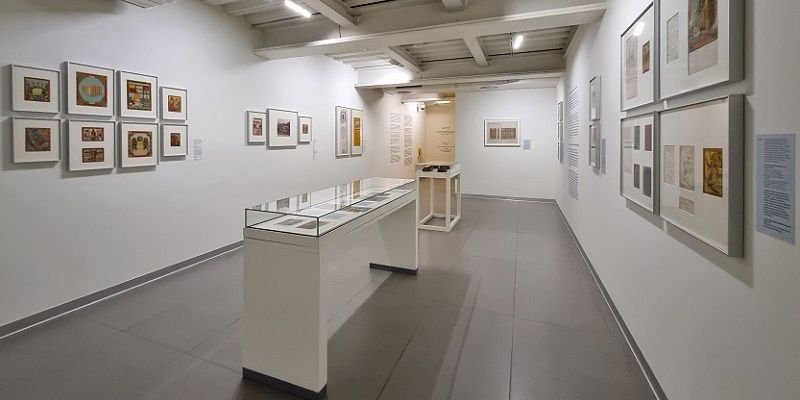
Launched in 2014, PhotoSparks is a weekly feature from YourStory, with photographs that celebrate the spirit of creativity and innovation. In the earlier 880 posts, we featured an art festival, cartoon gallery. world music festival, telecom expo, millets fair, climate change expo, wildlife conference, startup festival, Diwali rangoli, and jazz festival.
The Museum of Art and Photography (MAP) is showcasing two outstanding exhibitions titled Vaanyerum Vizhuthugal (meaning ‘Roots that Reach for the Sky’ in Tamil) and Ticket Tika Chaap (art of the trademark in Indo-British textile trade). See our coverage of earlier events at this popular Bengaluru venue here.
The photography exhibition was originally part of the Chennai Photo Biennale 2024-2025 and is curated by Jaisingh Nageswaran. The 12 featured artists include self-taught photographer Sathish Kumar, interdisciplinary artist Shankar Narayanan, performance artist Sridhar Balasubramaniyam, and visual artist and curator Steevez.

Priyadarshini Ravichandran uses photography to tell stories of women, their lives and the land. Vivek Mariappan specialises in automotive, architectural and environmental portraits.
The exhibition titled Ticket Tika Chaap is curated by Nathaniel Gaskell and Shrey Maurya. Gaskell is based in Singapore, while Maurya is MAP Academy’s research director.
“Textile tickets are multicoloured paper labels that were stuck to packed bolts or yardages of cloth made by British and Indian mills, which were sold in markets from the late 19th to around the mid-20th centuries,” curator Maurya tells YourStory.

.thumbnailWrapper{
width:6.62rem !important;
}
.alsoReadTitleImage{
min-width: 81px !important;
min-height: 81px !important;
}
.alsoReadMainTitleText{
font-size: 14px !important;
line-height: 20px !important;
}
.alsoReadHeadText{
font-size: 24px !important;
line-height: 20px !important;
}
}

The tickets typically followed a design schematic, where a central image was set within a border that carried the name of the mill or a merchant agency and the names of places where they were based or operated. “These labels were used to sell cloth, yarn and dyes in markets in colonial India, Africa, Latin America and South East and East Asia,” she adds.
“The labels represent multiple, overlapping histories. They were legal trademarks and some of the earliest colour advertisements to circulate in colonial India. They represented the industrialisation of the textile manufacturing industry, in both Britain and India, and also provided an insight into the global textile trade, shaped significantly by science, technology and colonialism in commerce,” Maurya says.
As creative objects, the labels were the result of the labour of many artists and printers who specialised in printing them at a mass scale. “As creative objects, particularly in their depiction of imagery, the labels illustrated how art and images circulated around the world at the time, and what meanings and messages such images could convey,” she says.

“As curators, Nathaniel Gaskell and I were fascinated by these ideas. We wanted to present these small, vividly coloured paper objects as windows into a larger world of the time that was interconnected through art, technology, business, and politics,” she recalls.
MAP has a large collection of tickets and related objects, numbering 7,000 items in all. This includes textile labels and archival registers maintained by lithographic printers making these tickets; records and forms of the trademarking process; original hand-painted label designs; and printing plates used in their production.
“The collection includes labels produced by Manchester-based printing firms like B. Taylor & Co., as well as labels by Indian printing establishments,” Maurya explains.

.thumbnailWrapper{
width:6.62rem !important;
}
.alsoReadTitleImage{
min-width: 81px !important;
min-height: 81px !important;
}
.alsoReadMainTitleText{
font-size: 14px !important;
line-height: 20px !important;
}
.alsoReadHeadText{
font-size: 24px !important;
line-height: 20px !important;
}
}

The curators began by digitising the entire collection and categorising them on the basis of imagery, intended use, or responses that the images were aimed to evoke in a consumer.
“We also examined the full geographical extent that the labels in the collection represented—over 125 cities from around the world are mentioned—and this gave us a better sense of trade geographies and the global footprint of the cotton economy of the time,” Maurya says.
In parallel, the curators’ research focused on the popular print culture of the time, which has been researched by scholars including Jyotindra Jain, Kajri Jain and Sumathi Ramaswamy. Another important source was the digital platform Tasveer Ghar, dedicated to an exploration of Indian popular print culture.

Textile labels belonged to the world of commerce as well as popular art. “They represent a time when, thanks to mass-printing, the image itself became a commodity in the marketplace,” Maurya explains.
“They also represent a time when mass-printing helped popular art in India come into its own. This was a phenomenon influenced by factors like colonial art school education of the 19th and 20th century, advances in mass-printing technology and the influence of theatre and stage design,” she adds.
This surge of popular imagery helped create a sense of a shared Indian identity at a time of colonial rule, and was reflected in textile labels as well. “Some labels show icons of the Indian independence movement, others show how local popular art like Ravi Varma prints were absorbed into the medium of commerce,” Maurya observes.

.thumbnailWrapper{
width:6.62rem !important;
}
.alsoReadTitleImage{
min-width: 81px !important;
min-height: 81px !important;
}
.alsoReadMainTitleText{
font-size: 14px !important;
line-height: 20px !important;
}
.alsoReadHeadText{
font-size: 24px !important;
line-height: 20px !important;
}
}

Textile labels can also be studied as advertisements. “The way textile labels responded to contemporary events and visual culture is remarkably similar to how modern advertising responds to trends, current events, and popular discourse,” she says.
For example, themes such as beauty, humour, modernity, and gender roles are evident across the imagery of the labels. “In many ways, these themes remain relevant and continue to play a central role in advertising,” Maurya affirms.
“This demonstrates how deeply rooted popular art—whether in print or digital form—is in the world of its time, and how its appeal and marketability rely on this embeddedness: on the ability to engage with local cultures, sentiments, ideas, and societal trends,” she adds.

The MAP team received a wide range of enthusiastic responses from visitors, and the exhibition has resonated with audiences of all ages. “A recurring reaction is a kind of aha moment, when people realise how closely advertisements and popular art, both then and now, are tied to the events and cultural moods of their time,” Maurya says.
Visitors often note that certain themes feel strikingly contemporary. These include the appeal of modernity, the lure of magical or whimsical worlds, humour, and the enduring power of beauty.
“These motifs still drive advertising today, and that continuity resonates strongly. Many are also surprised and delighted by the labels’ bright, vivid colours, their rich detail, and sheer diversity of motifs,” Maurya adds.

.thumbnailWrapper{
width:6.62rem !important;
}
.alsoReadTitleImage{
min-width: 81px !important;
min-height: 81px !important;
}
.alsoReadMainTitleText{
font-size: 14px !important;
line-height: 20px !important;
}
.alsoReadHeadText{
font-size: 24px !important;
line-height: 20px !important;
}
}

MAP makes a deliberate effort to ensure accessibility and inclusivity at all its exhibitions. “The audio guide has been very well received, but the most impactful feedback has come from visitors engaging with the tactile section—designed especially for the visually impaired,” she says.
This includes 3D models of labels, raised-line versions of tickets, maps with textured outlines, and Braille notes. “These features have helped open up the experience to a wider audience and have been particularly meaningful to many,” she proudly says.
The curators hope the audience takes a moment to absorb all aspects of label design—whether it is the central image or the ornate embellishments along the margins. “Many visitors may recognise familiar visuals, and we invite them to reflect on where they might have encountered such imagery before, and what such imagery has invoked within them,” Maurya says.

“As curators, we find it valuable to speak with visitors about which label stood out to them—there was always one image that resonated, even among nearly 400 on display. Different people were drawn to different visuals, and these varied responses are always revealing,” Maurya observes.
Given the number and range of labels in the exhibition, it seems likely that something will resonate with everyone. “It may even prompt a question about why a particular image holds such strong appeal,” Maurya signs off.
Now what have you done today to pause in your busy schedule and harness your creative side for a better world?










(All photographs were taken by Madanmohan Rao on location at MAP.)
Edited by Jyoti Narayan

